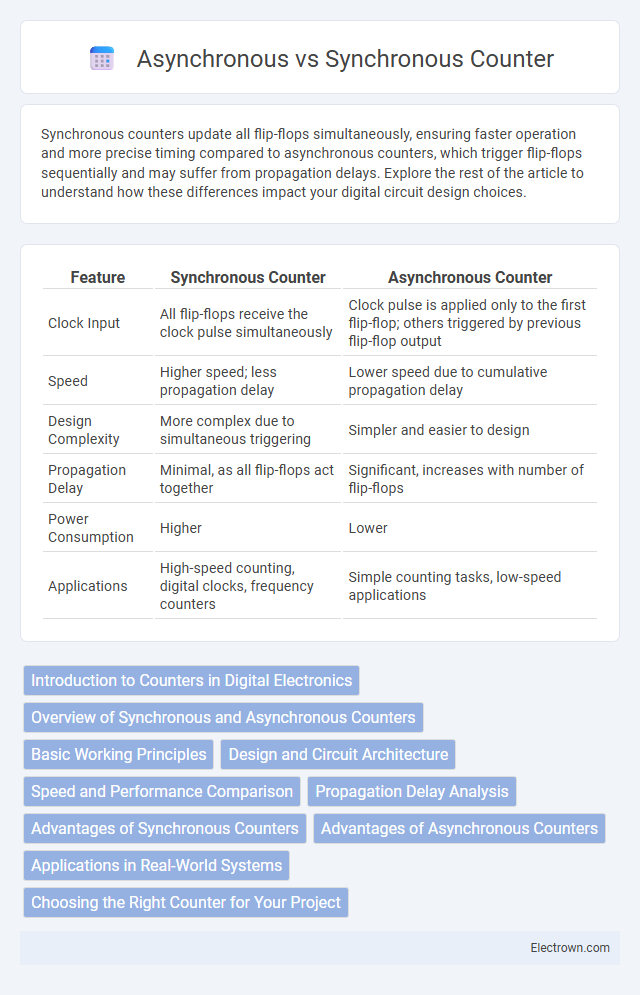Synchronous counters update all flip-flops simultaneously, ensuring faster operation and more precise timing compared to asynchronous counters, which trigger flip-flops sequentially and may suffer from propagation delays. Explore the rest of the article to understand how these differences impact your digital circuit design choices.
Table of Comparison
| Feature | Synchronous Counter | Asynchronous Counter |
|---|---|---|
| Clock Input | All flip-flops receive the clock pulse simultaneously | Clock pulse is applied only to the first flip-flop; others triggered by previous flip-flop output |
| Speed | Higher speed; less propagation delay | Lower speed due to cumulative propagation delay |
| Design Complexity | More complex due to simultaneous triggering | Simpler and easier to design |
| Propagation Delay | Minimal, as all flip-flops act together | Significant, increases with number of flip-flops |
| Power Consumption | Higher | Lower |
| Applications | High-speed counting, digital clocks, frequency counters | Simple counting tasks, low-speed applications |
Introduction to Counters in Digital Electronics
Counters in digital electronics are essential sequential circuits used to count pulses and keep track of events. Synchronous counters operate with all flip-flops triggered simultaneously by a common clock signal, ensuring faster and more reliable performance, while asynchronous counters trigger flip-flops in sequence, causing propagation delays. Understanding the differences between synchronous and asynchronous counters helps you select the appropriate design for applications requiring precise timing and speed.
Overview of Synchronous and Asynchronous Counters
Synchronous counters operate with all flip-flops triggered simultaneously by a common clock signal, ensuring faster and more reliable counting sequences. Asynchronous counters, also known as ripple counters, have flip-flops triggered in a sequence, where the clock input of one flip-flop is driven by the output of the previous one, causing propagation delays. The key difference lies in timing control, with synchronous counters offering precise timing and asynchronous counters being simpler but slower due to cumulative delay.
Basic Working Principles
Synchronous counters operate with all flip-flops triggered simultaneously by a common clock signal, ensuring uniform timing and faster counting speeds. Asynchronous counters, also known as ripple counters, have flip-flops triggered sequentially where the output of one flip-flop serves as the clock input for the next, causing propagation delays. Understanding these basic working principles helps you select the appropriate counter type for your timing and speed requirements in digital circuits.
Design and Circuit Architecture
Synchronous counters use a common clock signal for all flip-flops, ensuring simultaneous state changes and faster operation due to reduced propagation delay. The circuit architecture involves parallel clocking with combinational logic to determine the next states, resulting in simpler timing analysis and improved reliability. Asynchronous counters cascade flip-flops where each output serves as the clock input to the next, leading to ripple effects and longer propagation delays, but with simpler wiring and less complex design.
Speed and Performance Comparison
Synchronous counters operate with all flip-flops triggered simultaneously by a common clock, resulting in faster and more predictable performance compared to asynchronous counters, which have flip-flops triggered sequentially and accumulate propagation delays. The reduced propagation delay in synchronous counters enhances speed and reliability, making them suitable for high-frequency applications requiring precise timing. Your choice depends on the need for speed and performance, where synchronous counters outperform asynchronous ones in minimizing timing errors and latency.
Propagation Delay Analysis
Propagation delay in synchronous counters is significantly lower because all flip-flops receive the clock pulse simultaneously, enabling faster response and predictable timing. Asynchronous counters experience cumulative propagation delays since each flip-flop is triggered by the output of the previous one, causing increased overall delay proportional to the number of stages. This difference critically affects the maximum operating frequency and timing reliability in digital circuit designs.
Advantages of Synchronous Counters
Synchronous counters offer faster operation compared to asynchronous counters because all flip-flops receive the clock pulse simultaneously, eliminating propagation delay. Their design allows for more precise timing control and easier implementation in complex circuits, improving overall system reliability. You benefit from synchronous counters' enhanced speed and accuracy, making them ideal for high-performance digital applications.
Advantages of Asynchronous Counters
Asynchronous counters offer simplicity in design and require fewer hardware components compared to synchronous counters, making them cost-effective and easier to implement in basic applications. Their ripple effect allows for straightforward cascading in multi-bit counting, which can be advantageous for smaller-scale or low-speed circuits. You benefit from lower power consumption and reduced complexity when using asynchronous counters for tasks that do not demand high-speed synchronization.
Applications in Real-World Systems
Synchronous counters are widely used in high-speed applications like digital clocks, frequency dividers, and synchronous state machines where timing precision is crucial due to simultaneous clock pulse triggering. Asynchronous counters find applications in simpler, low-speed scenarios such as event counting, switch debouncing, and digital tally counters where propagation delay is less critical. Your choice between these counters impacts the performance and reliability of real-world digital electronics based on speed and complexity requirements.
Choosing the Right Counter for Your Project
Selecting between synchronous and asynchronous counters depends on your project's speed and complexity requirements. Synchronous counters update all flip-flops simultaneously, offering faster operation and reducing propagation delay, ideal for high-frequency applications. Asynchronous counters are simpler and use fewer components but suffer from cumulative delays, making them suitable for slower, less timing-critical tasks.
Synchronous vs asynchronous counter Infographic

 electrown.com
electrown.com